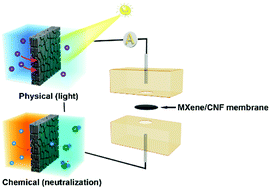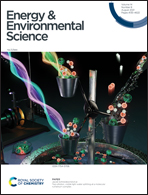Synergy of light and acid–base reaction in energy conversion based on cellulose nanofiber intercalated titanium carbide composite nanofluidics†
Abstract
Employing chemical-potential with reverse electrodialysis is a sustainable way to generate electricity. Based on this observation, efforts have been made to utilize this energy, such as the development of nanomaterials and the introduction of external fields. However, the reported systems mainly focus on a single type of physical field on the enhancement of energy conversion but ignore the synergy between cross-factor types. Here, we report a light and acid–base reaction enhanced energy conversion system based on 1D/2D composite nanofluidics. The contributions of light (physical) and acid–base reaction (chemical) in a chemical-potential-driven ionic generation system are studied separately and jointly. With the synergistic effect of the joint system, the output power density increases to 87.23 W m−2, exceeding the output power density of the state-of-the-art membrane-based systems. Both experimental and theoretical results indicate that the physical–chemical synergistic effect can significantly improve the magnitude of ionic migration. Hence, our work demonstrates the vast potential of a physical–chemical synergistic assistant factor in the enhancement of chemical-potential-driven energy conversion.



 Please wait while we load your content...
Please wait while we load your content...